Transformation |
||
Most of the buildings that withstood the bombing were military facilities, public institutions, financial institutions, and the like. After the war, former military facilities were initially used as government or public offices, or as educational facilities.
Here, we will introduce some buildings that are still in use but served quite different functions before the war. |
||
 |
||
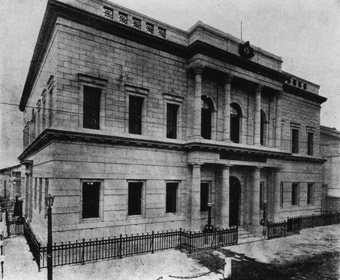 Mitsui Bank Hiroshima branch office in completion in 1925.
Mitsui Bank Hiroshima branch office in completion in 1925.Issue "the construction world" published in 1925 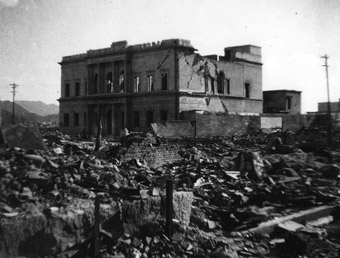 Photo taken from northwest. The west side of the roof collapsed.
Photo taken from northwest. The west side of the roof collapsed. Late August 1945. Taken by Naomichi Inoue 
* Location: 7-1 Hondori, Naka-ku * Distance from hypocenter: 360 meters * Name at time of bombing: Teikoku Bank Hiroshima Branch * Structure/number of stories: Reinforced concrete, two stories * Completed: 1925 * Name when completed: Mitsui Bank Hiroshima Branch * Current status: Bakery shop |
Hiroshima Andersen
Near the center of Hondori shopping arcade a large bakery, restaurant and banquet hall called "Hiroshima Andersen." The part of the Andersen building that faces Hondori was constructed about eighty years ago to serve as a bank. The bank building was badly damaged by the atomic bomb. Six night-duty personnel and twelve or thirteen female employees were in the bank at the time, but none are known to have survived. At one point, a debate took place about whether to preserve the Hiroshima Prefectural Industrial Promotion Hall (A-bomb Dome) or the Teikoku Bank as a symbol of Hiroshima. But after repairs were completed in 1950, the bank reopened. In 1967 Takaki Bakery, which makes and sells bread and pastries, acquired and renovated this building for use as a shop and restaurant. In 1978 a new eight-story wing was constructed on the south side of the site. This large-scale remodeling and expansion project was designed to integrate the new wing with the original A-bombed building. The second-story window frames visible from Hondori appear as they did when first constructed. 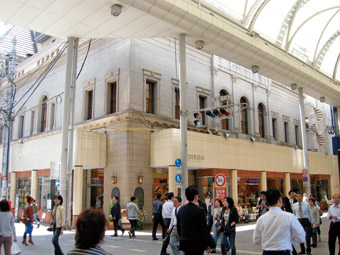 As seen from Hondori. Second floor still as originally designed and constructed. May 2008. |
|
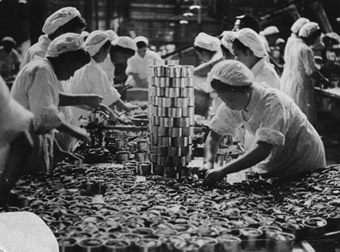 Packing meat inside the cannery.
Packing meat inside the cannery. 1940-42. Taken by Takeo Uchiyama / Collection of Shigeru Uchiyama / Courtesy of Hiroshima City Museum of History and Traditional Crafts 
* Location: 2-6-20 Ujina-miyuki, Minami-ku * Distance from hypocenter: 3,210 meters * Name at time of bombing: Ujina Army Provisions Depot * Structure/number of stories: Brick/steel-framed, one story (now with partial second story) * Completed: 1911 * Name when completed: Ujina Army Provisions Depot * Current status: Hiroshima City Museum of History and Traditional Crafts |
Hiroshima City Museum of History and Traditional Crafts
As the Pacific War intensified, canning production continued until the end of 1944, but much of the machinery was evacuated. At the time of the bombing, mobilized students were engaged in farming and other activities for the depot. Personal injuries were minimal, and buildings, too, escaped collapse.
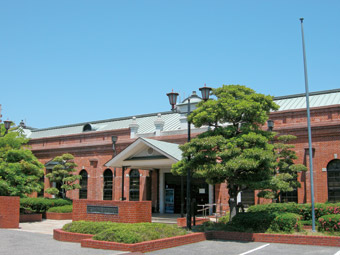 Hiroshima City Museum of History and Traditional Crafts. May 2008. |
|
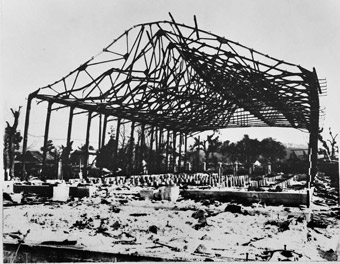 The auditorium was gutted by fire, the steel frame bent.
The auditorium was gutted by fire, the steel frame bent. Around November 1945. Taken by U.S. Army  * Location: 2-1-34 Higashi-senda-machi, Naka-ku * Distance from hypocenter: 1,690 meters * Name at time of bombing: Senda Elementary School auditorium * Structure/number of stories: Steel-framed, one story * Completed: 1929 * Name when completed: Senda Normal Higher Elementary School auditorium * Current status: Enclosure for small animals with steel auditorium framework preserved |
Senda Elementary School Aviary
evacuated, but those who remained were in class. Of the dozen or so students and four or five school staff members at the school that day, three of the students and one staff member died instantly. The flames that erupted shortly after the bombing burned wooden buildings to the ground. All that remained was the auditorium's steel frame. As recovery proceeded, the wreckage of the auditorium was left as it was, but in 1956, it was transformed into an aviary. It remains a place of learning for students.  Utilizing the bomb-damaged steel frame, the school built an aviary.
Utilizing the bomb-damaged steel frame, the school built an aviary. May 2008. |
|
